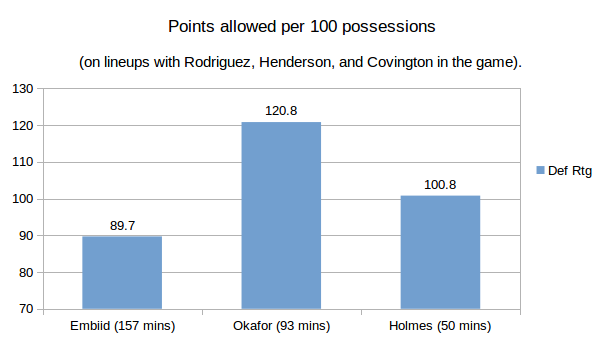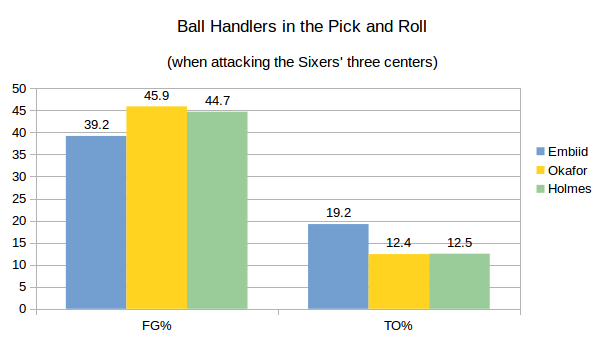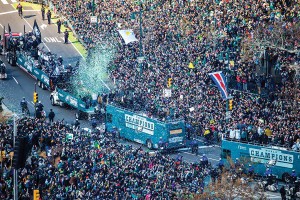Joel Embiid’s Defensive Impact a Rarity Among Rookie Big Men

Joel Embiid knocks the ball away from Terrence Jones during last week’s win over the New Orleans Pelicans | Derick E. Hingle-USA TODAY Sports
On paper, last week’s 99-88 victory over the New Orleans Pelicans was a run-of-the-mill victory over a bad team, or at least as run-of-the-mill as a victory can get for a team coming off an eight game losing streak and who hadn’t won a game on the road in nearly a full calendar year.
But the Pelicans are struggling, an already under-talented team missing multiple starters and having lost five of their last six heading into the contest with the 76ers.
And on the surface, Joel Embiid had an okay game, with a stat line of 14 points, albeit on just 5-15 shooting from the field, and 7 rebounds in 27 minutes of playing time.
Over his last two games Embiid has struggled offensively for really the first time in his NBA career, shooting just 33.3 percent from the field, forcing shots, and, at times, slow to react to the double teams being thrown his way. In many ways this is notable not because it’s happening to Embiid, but because it took so long for him to really look like the inexperienced rookie that he is. It’s a very temporary setback for a player oozing with two-way potential.
Yet Embiid’s past two games were some of the best games he’s played this year, despite the offensive struggles. And when you go beyond the surface layer the trends that have been established over the course of this young season are pretty exciting to think about.
The first indication of Embiid’s enormous impact in that Pelicans game show up in the rest of his box score, which included 4 blocks, 3 steals, and 2 assists. It also included a team-high +27 in the plus-minus, a fact that head coach Brett Brown was quick to point out after the game, with the Sixers outscoring the Pelicans 66-39 during the 27 minutes Embiid was on the court.
It was as if two different games were being played, with two different strategies by the opponent based solely on the availability of one Joel Hans Embiid.
When Embiid was in the game, the Pelicans scored 82.1 points per 100 possessions. That jumped to 103.9 when Embiid was on the bench. When Embiid was in the game, the Pelicans committed turnovers on 21 percent of their offensive possessions, but did so just 4.2 percent of the time when Embiid was on the bench. They collected 26.9 percent of their misses when Embiid was sitting compared to just 20 percent when the 7-foot-2 rookie was there to clean the defensive glass. With Embiid on the court the Pelicans shot 53.8 percent in the restricted area, which jumped all the way up to 61.9 percent when he was on the bench.
Just in that game against New Orleans, Embiid showed the ability to control the glass defensively, rotate from the weakside to meet, and best, Anthony Davis at the rim, switch onto Buddy Hield and force an airball, trap Langston Galloway 30 feet from the basket, and also switch on to Galloway later in the game to block a three-point attempt. It’s a combination of physical skills and mental wherewithal that you don’t frequently find in a 22-year-old, 7-foot-2 center.
But those stats, and even those athletic feats, can sometimes be noisy, rare glimpses of potential not capable of being sustained over the course of an 82 game season. For Embiid, however, it’s been a consistent trend that has been developing all season, and one that is backed up by video evidence.
It’s been frequently stated, including numerous times by Brett Brown himself, that the Sixers defensive performance of allowing just 97.9 points per 100 possessions in the 353 minutes that Embiid’s been on the court would be the best defensive rating in the league. The 108.0 points per 100 possessions that the Sixers give up when Embiid’s on the bench would be the fifth worst, a number which is saved in part by Sunday’s stomping of the tired Detroit Pistons, who were finishing up a four-games-in-six-nights stretch of play. Prior to that game the Sixers had given up 109.4 points per 100 possessions with Embiid on the bench, which was the worst in the league at the time.
When Embiid’s been in the game the Sixers have outscored their opponent 722-710, which becomes even more shocking when you consider that’s mostly been against the other team’s starters, something which seems patently absurd considering the overall talent level on this squad. It also, for a team that’s just 6-18 on the season and loses by an average of 7.6 points per game, hints at just how much the Sixers’ competitiveness falls off of a cliff when Embiid is taken to the bench.
The polar opposite ends of the spectrum that those two numbers represent may not withstand the test of time, but they do illustrate just how much the game is changed by Embiid’s presence.
* * * *
One of the inherent difficulties in looking at on-court/off-court lineup data is the differences in the circumstances in the minutes that each player receives. Over time context becomes blurred and the sample becomes more representative, but it can take significant time for that to be true.
The unique situation the Sixers are in, with 3 players — Embiid, Jahlil Okafor, and Richaun Holmes — splitting time at center provides for some interesting dynamics in looking at lineup data. With Embiid and Okafor both on a minutes restriction, not to mention Embiid missing nine contests because of his a combination of his back-to-back restrictions, rest, and injury, and with Okafor missing three games due to illness, all three centers have started, and received at least a decent chunk of minutes with the other starters.
That helps minimize two key points of context: teammates and, to a lesser degree, quality of opponent. Not by any stretch removing them from the equation entirely, but at least getting more of an apples-to-apples comparison than you would typically get 24 games into the season.
Three players have been relative fixtures in the Sixers starting lineup, with Sergio Rodriguez (started 22 of 24 games at point guard), Gerald Henderson (23 starts), and Robert Covington (21 starts) forming a relatively consistent part of Brown’s starting lineup.
Embiid has, of course, started at center when he’s been available, but that’s left 9 starts for Okafor (who has started 7 games in Embiid’s place) and Holmes (2 starts).
The final piece of the puzzle has been power forward, with 10 starts going to Dario Saric, then 14 to Ersan Ilyasova after the veteran forward was acquired in early November.
Over the last few years, the Sixers high-end draft picks haven’t shared the court with much legitimate, NBA-starter level talent. That hasn’t been the case this season, especially on the wings. While Robert Covington has struggled mightily on the offensive side of the court for much of the year, he’s turned himself into a very good perimeter defender, and along with Gerald Henderson gives the Sixers more defensive competency on the perimeter than they’ve had in quite some time.
Covington and Henderson, when anchored by a defensive-minded center, can compete at an NBA level on the defensive side of the court, and that makes looking at the impact Embiid has made with that unit interesting.
So far, Embiid has played 157 minutes with all of Rodriguez, Henderson, and Covington on the court, which includes 72 minutes with Saric as the power forward, 78 minutes with Ilyasova, and 7 minutes with “others” (3 minutes with Okafor, 2 minutes with Covington at the 4 and Stauskas on the wing, and 2 minutes with Covington at the 4 and Thompson on the wing). Okafor has played 93 minutes with Rodriguez, Henderson, and Covington all on the court, and Holmes 50.
That lets us isolate the different variables, even if just a little bit, and even with the caveat that the sample size is still relatively small and we’re in no way providing information that is meant to be predictive, just eyebrow raising and water-cooler-discussion generating.
Yet the difference in team results just by substituting the center has been staggering. Below is a graphic with defensive rating (points the Sixers allow per 100 possessions) with the three mainstays (Rodriguez, Henderson, and Covington) on the court, and how the team performs with each of the three centers included with that lineup.

(How lineups with Rodriguez, Henderson, and Covington have performed defensively by swapping out the center they’re paired with.)
The reasons why are pretty consistent. When paired with the Sixers’ perimeter starters, the team rebounds more (82.7 percent defensive rebounding rate) with Embiid on the court, holds the opponent to just 39.6 percent shooting, and just 35.2 percent from three-point range, and forces turnovers on 15 percent of the opponents possessions.
| Center | Mins | Opp FG% | Opp 3pt% | DRB% | Opp TO Rate | Opp Points in Paint (per 100 poss) |
|---|---|---|---|---|---|---|
| Embiid | 157 | 39.6% | 35.2% | 82.7% | 15% | 33.3 |
| Okafor | 93 | 54.4% | 52.1% | 76.1% | 14.4% | 42.2 |
| Holmes | 50 | 45.3% | 33.3% | 84.1% | 11.5% | 41.7 |
(Note on the above table: any individual metric is highly susceptible to small sample size at this stage. Embiid’s 157 minutes with those lineups is slightly more convincing than Holmes’ 50, but it’s a relatively low total for all of them. It’s more the consistency of Embiid’s impact across the board that is impressive than any individual statistic).
His individual defensive metrics are just as stellar. The man Embiid’s defending is shooting just 42.2 percent on the season, including just 44.9 percent on shots within 6-feet of the basket, shots they usually make at a 59.8 percent clip. When an opponent (either Embiid’s man or not) attempts a shot near the basket with Embiid in the vicinity, they shoot just 41.4 percent, a dominating figure when taken in a league-wide context (below). Opponents are shooting just 39.2 percent and turn the ball over nearly 20 percent of the time when a ball handler tries to attack Embiid in a pick and roll, which doesn’t even take into account the passes Embiid forces because of his surprisingly nimble feet.
| Player | FG Def at Rim/48 mins | FG% against |
|---|---|---|
| Joel Embiid | 15.1 | 41.4% |
| Jahlil Okafor | 12.9 | 49.2% |
| Richaun Holmes | 13.7 | 52.1% |
| Nerlens Noel (2014-15) | 14.8 | 44.9% |
| Rudy Gobert | 16.7 | 42% |
| Hassan Whiteside | 14.1 | 45.3% |
| Kristaps Porzingis | 10.6 | 40.8% |
| Anthony Davis | 9.2 | 47.2% |
| Karl-Anthony Towns | 8.9 | 50.3% |
(Related to that table above: look at the discrepancy in the number of shots altered by those playing with two-big lineups, as guys like Anthony Davis and Karl-Anthony Towns are largely defending the power forward spot, and thus have their defensive impact minimized unnecessarily. This is why I included Noel’s 2014-15 stats for comparison).

(How opposing ball handlers do in the pick and roll when attacking the Sixers’ three centers)
Interior defense, weakside defense, pick and roll defense, controlling the glass. Embiid offers far more defensive versatility, and consistency, than any 22-year-old, 7-foot-2 rookie has any right to do.
As consistent as Embiid’s impact has been, it should only improve in time as Embiid’s recognition naturally improves with a diversity of experience, a scary proposition for opponents considering he already seems to be processing information at an exceptionally high rate, something which his coach has taken notice of. “I feel like his processing of what he should be doing…is really elite. I think he sees the game at a pretty strong intellectual level given how little he has played,” Brown said a few weeks ago.
Brown has also alluded to the fact that Embiid is still just figuring out what to do, strategically, when defending the pick and roll. Which is exciting considering he’s already, by far, the team’s best (healthy) pick and roll defender among the big men.
In reality, Embiid is still figuring out *everything*, which is rather remarkable since he’s already such a good all-around defender. Young big men like Karl-Anthony Towns, who seemingly has all the physical tools and motivation to be a good defender down the line but hasn’t yet figured out how to translate that into impact, are the norm. Embiid, with the ability to transform a team defensively from day one, is the unicorn, and his diverse (and rare) physical tools, his natural defensive instincts, his ability to process information on the fly, and his incredible learning curve only hint at the defensive force he will grow into eventually.
Now if there was only a center on the roster capable of preventing the team from hemorrhaging points when Embiid’s on the bench. That’s a guy I’d have interest in keeping around.
* * * *
Lineup experimentation
With the Sixers back at Camden preparing for a brief homestand, head coach Brett Brown got to talking about his lineups with all three big men seemingly on the precipice of playing together, something which hasn’t happened yet this season. Noel returned on Sunday, playing 10 first-half minutes before spraining his ankle in a game where Embiid wasn’t available due to elbow inflammation.
In addition to that, rookie Ben Simmons had his boot removed from his foot and began taking free-throws in sneakers, a significant step towards his return.
All of these additions carry with it a necessity to shuffle rotations. Embiid told the media yesterday that he played mostly the 4 on offense, and Brown said that the biggest change in the rotation would be Saric playing almost exclusively at small forward now. Brown has also recently talked about letting Ben Simmons play point guard on both sides of the court, although he later clarified that to say Simmons would only be guarding point guards when the other team tries to defend Simmons with a point guard, to avoid the need to cross-match a ball handler in transition. That doesn’t seem like it’s likely to happen all that often.
Still, all of this brings up an interesting dynamic. With 4 natural centers (Embiid, Noel, Okafor, Holmes) and 3 natural power forwards (Simmons, Saric, Ilyasova), Brown will have to get creative with his lineups to get everybody the minutes they need, whether those minutes are for development reasons or to showcase for a trade, not that those two are necessarily mutually exclusive.
Yet while experimentation is good for the here and now, there’s also something to be said for taking your two elite talents (Simmons and Embiid) and putting them in the best position to succeed, and not minimizing their effectiveness by trying to shoehorn in limited, temporary pieces.
Embiid is best positioned as the only big in a 4-out offensive system, giving him the space to roll to the hoop, face up and drive, post up, and, occasionally, pop out to the three-point line to stretch the defense. Simmons, as we recently discussed, is best served as close to the rim defensively as he can get to help ignite the Sixers’ (all of a sudden stagnant) fast break.
Experiment with these lineups now, learn what you can, give minutes to the guys who deserve it. But Embiid at the 4, Saric at the 3, and Simmons defending the point aren’t likely to be their long-term roles.
Derek Bodner covers the 76ers for Philadelphia magazine. Follow @DerekBodnerNBA on Twitter.


